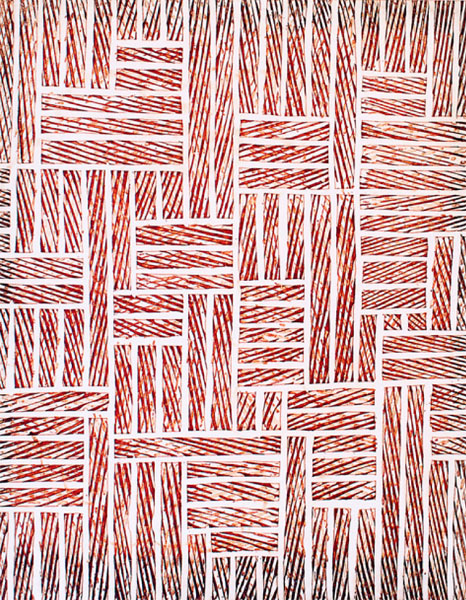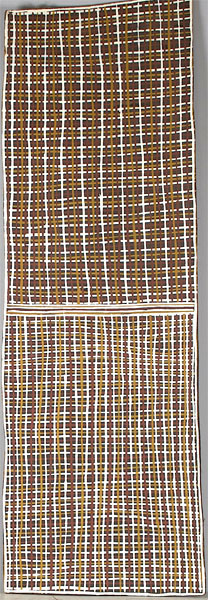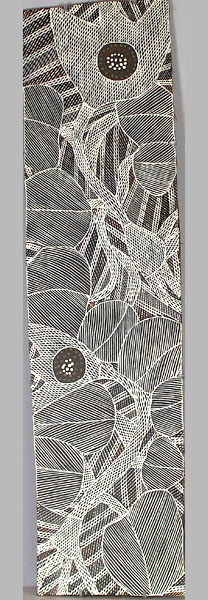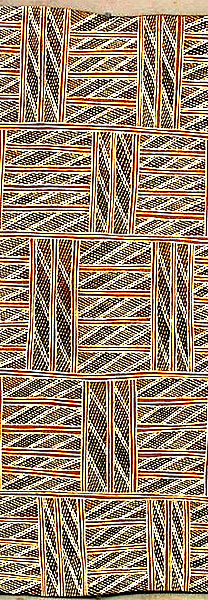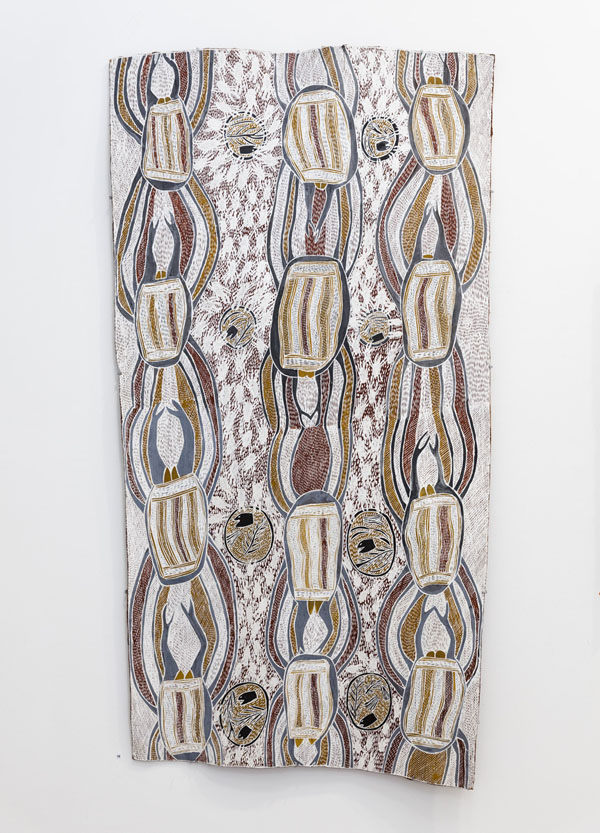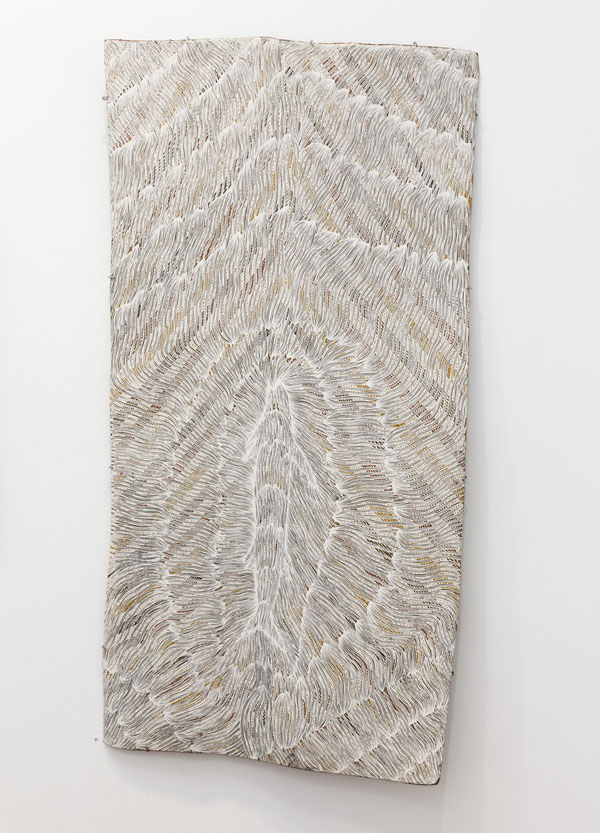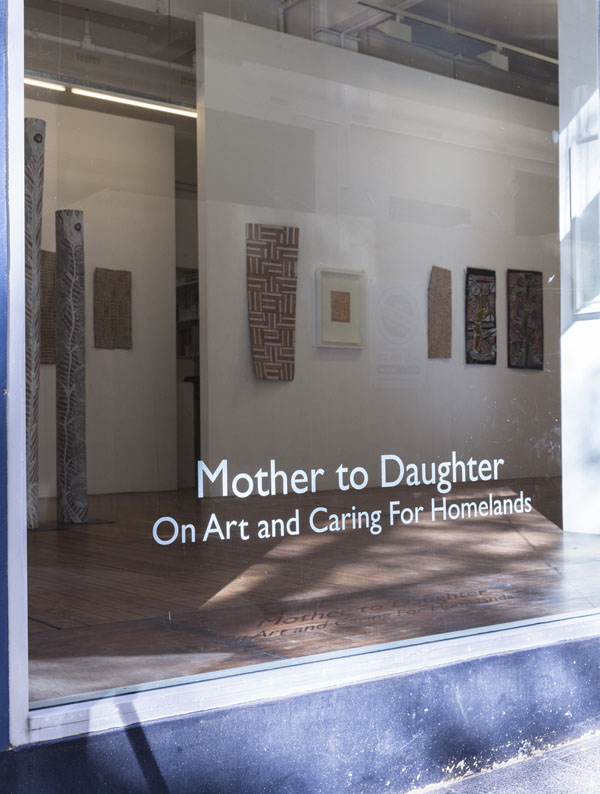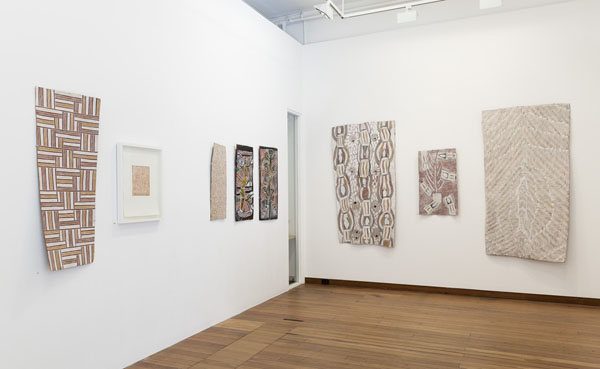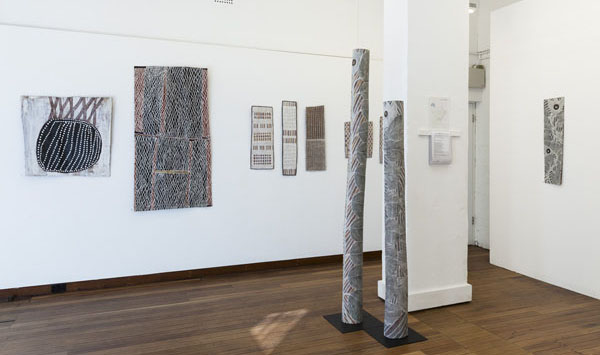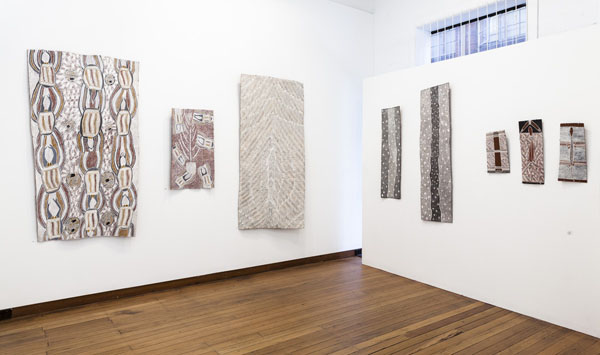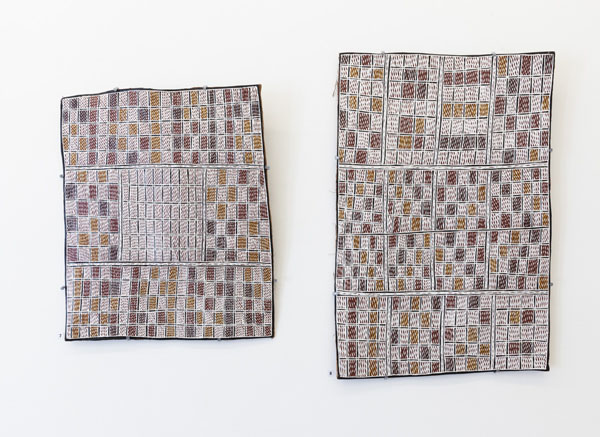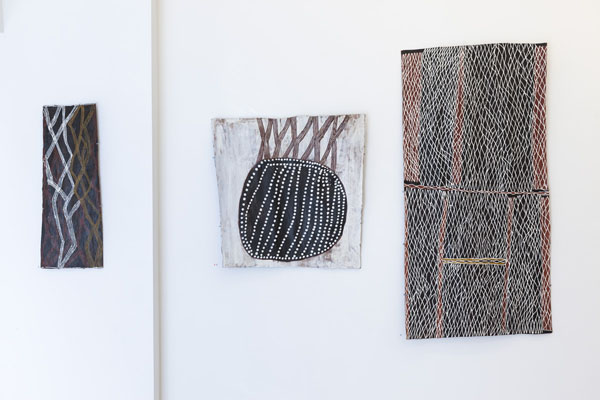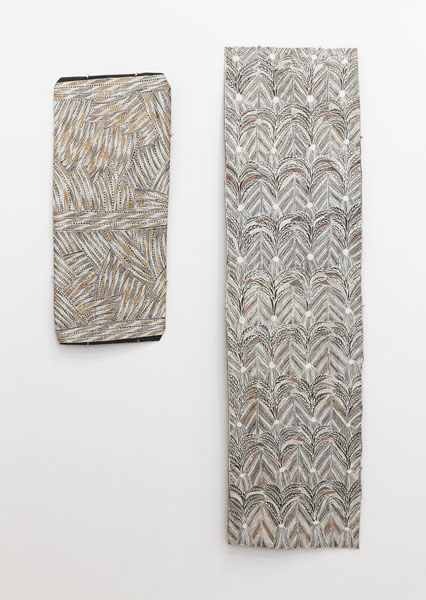
Mother to Daughter: On Art and Caring for Homelands — 30 April to 6 June 2015
Mother to Daughter: On Art and Caring for Homelands celebrates leading women painters and their daughters at the renowned Buku-Larrnggay Mulka Centre at Yirrkala, a small Aboriginal community on the northeastern tip of the Top End. Presented by The Cross Art Projects and Buku–Larrnggay Mulka Centre.
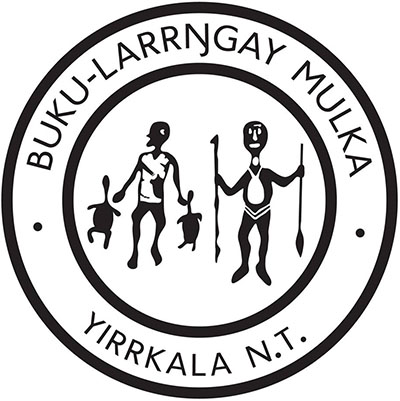
The intergenerational artist pairs are Mulkun Wirrpanda & Yalmakany Marawili; Nongirrna Marawili & her two daughters Marrnyula Munungurr and Rerrkirrwana Munungurr; Malaluba Gumana & Djurayun Murrinyina; Banduk Marika & Ruby Djikarra Alderton; the late Gulumbu Yunupingu & Dhambit Munungurr; Galuma Maymuru & Liyawaday Wirrpanda; Naminapu Maymuru-White & Narrawu Wanambi. Rarely are these artists seen side-by-side outside big museum shows such as the sensational Yirrkala Drawings national tour in 2014.
Exhibition: 30 April to 6 June 2015
Cross Conversations: 12 May at 6.30pm, Kade McDonald, Art Co-ordinator, Buku-Larrngay Mulka;
Saturday 6 June at 3pm, ‘Another way of telling the story’: The History of Experimental Printmaking at Yirrkala with Denise Salvestro, PhD Candidate at ANU Research School of Humanities & Arts.
Nongirrna Marawili, Rock and Seaspray, 2015. Bark painting, 77 x 78 cm
Ruby Djikarra Alderton, Yalangbara, 2012. Etching, image 20 x 25 cm, edition 30.
Ruby Djikarra Alderton, Yalangbara, 2012. Etching, image 20 x 25 cm, edition 30.
Marrnyula Munungurr, Djapu Gapu, 2015. 76 x 25 cm
Malaluba Gumana, Garrimala, 2015, 88 x 22 cm. (4696F)
Djurayun Murrinyina, Wukili, 2014, 22 x 80 cm. (4586C)
Djurayun Murrinyina, Wukili, 2014, 65 x 32 cm (4610F).
Banduk Marika, Yalangbara, 2014, 45 x 120 cm
Galuma Maymuru, Muthimuthi, 2014 (4628U). Bark painting, 174 x 93 cm. Photo credit silversalt photography.
Liyawaday Wirrpanda, Mana at Yalata, 2015 (4115P). Bark painting, 188 x 84 cm. Photo credit silversalt photography.
Mother to Daughter, Installation view, 2015. Photo credit silversalt photography.
Malaluba Gumana, Dhatam at Garrimala, 2011. Larrakitj, 174 cm height. Photo credit silversalt photography.
Mother to Daughter: On Art and Caring for Homelands contributed to Future Feminist Archive, a year-long series of exhibitions, workshops and talks at The Cross Art Projects and elsewhere which investigated and reviewed changes over the decades since International Women’s year (1975). We evaluated how feminism broke new ground in Australian contemporary art by documenting and theorising feminist aesthetics, organisational methods and its political effectivity.
In the late 1970s and 1980s, the radical changes introduced by the homelands movement and the Aboriginal Land Rights (Northern Territory) Act 1976, helped set aside the divisive art world categories of urban versus traditional, or innovative versus static contemporary Indigenous art. One of many decisive moments was when a number of senior lawmen taught their daughters to paint sacred imagery onto bark at Yirrkala, an innovation that produced some of the most renowned Australian painters of the late-20th century. They knew that the Indigenous cultural knowledge base and contemporary art was of inestimable value for Australia and the world, and needed to survive destructive impacts, such as that of a bauxite mine they had recently fought so hard to stop.
One of the first to break the curatorial silence on art by tribally oriented Aboriginal women in feminist discourse was Banduk Marika. In 1982 she mounted the first of several exhibitions of women’s work from Arnhem Land at Seasons Gallery in North Sydney (which she ran with writer Jennifer Isaacs). When Banduk and her family returned to Yirrkala, she managed Buku-Larrnggay Mulka Art Centre.(1) Banduk is affiliated with Yalanbara and Gulurnya homelands—the land on which the art centre stands. At the art centre today the primarily Yolngu staff of around twenty service Yirrkala and surrounding homeland centres. A print workshop and digital production studio—the dream of Banduk Marika—give options for experiment and a place for youngsters, such as her daughter Ruby Alderton, to learn on the job.(2)
Amongst the first women to paint sacred clan designs was Galuma Maymuru, instructed by her father, the great Narritjin. Gulumbu Yunupingu was instructed by Munggurrawuy Yunupingu, while Banduk Marika and her sisters were taught Rirratjingu clan designs by their father, Mawalan Marika. Naminapu Maymuru-White was taught to paint Mangalili clan designs by two well-known Yolngu artists— her father, Nanin Maymuru, and her father’s brother, Narritjin Maymuru. These celebrated women in turn teach their daughters how
to paint the minyitj of their homelands while working from these autonomous centres. Most artists also teach or work as rangers.
The mothers (and some daughters) in Mother to Daughter: On Art and Caring for Homelands were finalists in the National Aboriginal and Torres Strait Islander Art Awards at the Museum and Art Gallery of the Northern Territory, winning several prizes. Their brilliant paintings detail the bonds between people and their heritage, and make complex allegorical and moral references that show, as anthropologist Howard Morphy observes, ‘the values of their way of life and the core structures of their society’.(3)
Generational shifts and changes in materials have transformed the ‘classic’ Yolngu aesthetic, by enabling brighter cross-hatching and the easy moves from body scale to museum scaled work, for example. Some artists, such as Naminapu Maymuru White and Gulumbu Yunupingu (dec.) or Malaluba Gumana (dec.), paint in secular styles of intricately repeated expanses of stars, water lillies or swarming crabs. Their shimmering white surfaces urge us to look deeper into underlying symbolic connections and mythic connotations, perhaps to reach further than the last stars. Yolngu artists continue to use art to fight for lasting rights and equality, resolute against the undermining of hard-won legal victories like the Land Rights Act—however inadequate these victories may prove in the face of colonial powers— and to continue to fight against diminishment.
This exhibition was set against the background of predatory threats from governments to close homelands. The federal government’s military- style ‘intervention’, undertaken hand-in-glove with the Northern Territory administration, emboldened resource-rich Western Australia to announce (in late 2014) the closure up to 150 communities by denying basic services of water, power and schooling. This policy has since been reversed but has left lasting damage.
As Eminent artist and Yolngu cultural leader Djambawa Marawilli beautifully expresses: ‘We are the archaeologists and anthropologists. Our Elders are passing on traditional knowledge in Yolngu and ancient Indigenous languages and university systems, which are still strong and real and rolling on…We want Australians to properly understand that our traditionally grounded contemporary art is not principally about beautiful objects, but, with ancient patterns and designs, shares our living ancestral understanding and specific connection to Country…The community Art Centre network across Australia is an outstanding example of contemporary Indigenous agency. Our inherited patterns and designs are our identity and also a “talking stick”, title deed, weapon, and means of economic empowerment. Please join to walk with us.’(4)
Footnotes
1. Banduk Marika interviewed by Vivienne Johnson in Dissonance: Feminism and The Arts 1970- 1990, Catriona Moore ed., 1993.
2. Dr Denise Salvestro, ‘Another way of telling the story: On the development of the Print Space at Yirrkala’, talk at The Cross Art Projects, 2015 and Balnhdhurr—A Lasting Impression, a touring exhibition presented by Artback NT in association with Buku- Larrnggay Mulka Centre.
3. Howard Morphy, Becoming Art: Exploring Cross-Cultural Categories, 2007.
4. Djambawa Marawilli, ‘On Art and Caring for Indigenous Knowledge’, ANKA Arts Backbone, Volume 14: Issue 2, December 2014/January 2015.
Download full text: Djambawa Marawilli, ‘On Art and Caring for Indigenous Knowledge’, ANKAA Arts Backbone, V14: Issue 2, January 2015.
The History of Experimental Printmaking at Yirrkala with Denise Salvestro, PhD Candidate at ANU, Saturday 6 June 2015.
Mother to Daughter Installation view, XAP 2015. Mother and daughter: Banduk Marika, Yalangbara, 2014, 45 x 120 cm and Ruby Djikarra Alderton, Yalangbara, 2012. Etching (framed). Mother and daughter: Gulumbu Yunupingu (dec), Ganyu, 2013, 80 x 28 cm and Dhambit Munuggurr. Photo credit silversalt photography
Mother to Daughter Installation view, XAP 2015. Mother and daughter: Banduk Marika, Yalangbara, 2014, 45 x 120 cm and Ruby Djikarra Alderton, Yalangbara, 2012. Etching (framed). Mother and daughter: Gulumbu Yunupingu (dec), Ganyu, 2013, 80 x 28 cm and Dhambit Munuggurr. Photo credit silversalt photography
Mother to Daughter Installation view, XAP 2015. Mother and Daughter: Nongirrna Marawili, Rock and Seaspray, 2014 and Yathikpa, 2013 and Marrnyula Munungurr, Djapu Gapu, 2015, Djapu Gapu, 2013, and Djapu Gapu, 2014, 76 x 25 cm. Mother: Malaluba Gumana, Dhatam at Garrimala, 2009. Larrakitj, 217 cm and Larrakitj, 174 cm. Photo credit silversalt photography
Mother to Daughter Installation view, XAP 2015. (Left) Mother and daughter: Gulumbu Yunupingu (dec), Ganyu, 2013, 80 x 28 cm and Dhambit Munuggurr. (Right) Mother and daughter: Naminapu Maymuru-White, Mi\iyawuy- Milkyway, 2015, 112 x 33 cm and 195 x 42 cm and Narrawu Wanambi three small paintings. Photo credit silversalt photography
Mother: Banduk Marika, Yalangbara, 2014, 45 x 120 cm.
Daughter: Ruby Djikarra Alderton, Yalangbara, 2012. Etching, image 20 x 25 cm. Mother to Daughter XAP 2015. Photo silversalt photography
Rerrkirrwana Munungurr, Djapu Miny’tji, 45 x 37 cm.
Rerrkirrwana Munungurr, Djapu Gapu, 2015, 59 x 39 cm. Daughter of Nongirrna Marawili.
Mother to Daughter, XAP 2015.Photo credit silversalt photography
Mother to Daughter Installation view, XAP 2015. Nongirrna Marawili, Yathikpa, 2014, 76 x 25 cm. Nongirrna Marawili, Rock and Seaspray, 2014, 77 x 71 cm. Nongirrna Marawili, Yathikpa, 2013, 148 x 78 cm.Photo silversalt photography
Mother: Mulkun Wirrpanda, Lutumba, 2013, 92 x 41 cm. Daugher: Yalmakany Marawili, Darrangi, 2012, 172 x 46cm, XAP 2015. Photo: silversalt photography
Acknowledgements
Thanks to the artists’ representative galleries for their support. Special thanks to the curatorial team at Buku-Larrnggay Mulka Centre (Will Stubbs, Kade McDonald and Andrew Blake) and to centre art workers for the artist biographies and artwork stories.
References
Vivien Johnson, ‘Interview with Banduk Marika, Sydney 1986’, in Dissonance. Feminism and the Arts 1970-90, ed., by Catriona Moore, Artspace, 1994.
Djon Mundine, ‘Saltwater’, in Saltwater: Yirrkala Bark Paintings of Sea Country, Buku-Larrnggay Mulka Centre, Yirrkala, 1999, p. 22.
Howard Morphy, Becoming Art. Exploring Cross-Cultural Categories, UNSW, 2008, pp. 50-51.
Links
Buku-Larrnggay Mulka Centre at Yirrkala NT – http://www.yirrkala.com/
Mother to Daughter: On Art and Caring for Homelands, Sydney Morning Herald, June 6 2015 > Download pdf
News on Stop Homeland Closures
Kimberley Land Council News Room at http://www.klc.org.au/news-media/newsroom/news-detail/2015
The Stringer, Independent News at http://thestringer.com.au/
Videos
Speech by Gerry Georgatos on National Day of Action, Canberra, March 19 2015 (Six-minutes). https://vimeo.com/122621762
NITV interview of Jeff McMullen on ‘Government sponsored land grab – “Pushing people off the Homelands”‘, January 2015 (Three-minutes).
https://www.youtube.com/watch?v=y3Tdb3RSavw



